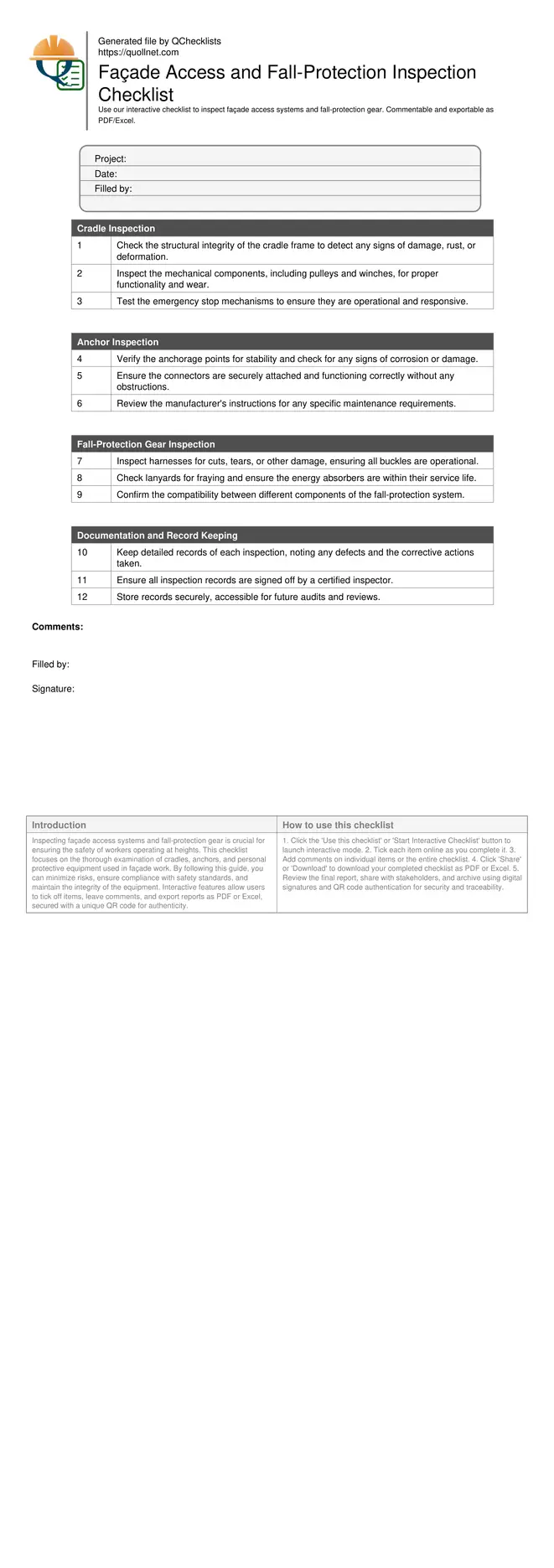Façade Access Systems and Fall-Protection Gear Inspection
Inspecting façade access systems and fall-protection gear is crucial for ensuring the safety of workers operating at heights. This checklist focuses on the thorough examination of cradles, anchors, and personal protective equipment used in façade work. By following this guide, you can minimize risks, ensure compliance with safety standards, and maintain the integrity of the equipment. Interactive features allow users to tick off items, leave comments, and export reports as PDF or Excel, secured with a unique QR code for authenticity.
- Ensure worker safety by thoroughly inspecting façade access systems and fall-protection gear.
- Identify potential hazards and compliance issues before they become critical.
- Maintain equipment integrity to extend its lifespan and reliability.
- Interactive online checklist with tick, comment, and export features secured by QR code.
Cradle Inspection
Anchor Inspection
Fall-Protection Gear Inspection
Documentation and Record Keeping
Why Regular Inspections Matter
Regular inspections of façade access systems and fall-protection gear are essential for preventing accidents and ensuring compliance with safety regulations. These inspections help identify potential issues before they lead to equipment failure or accidents. By maintaining a consistent inspection schedule, organizations can protect their workforce and avoid costly liabilities.
- Prevent accidents through early detection of issues.
- Ensure compliance with safety standards and regulations.
- Extend the lifespan of equipment with regular maintenance.
- Avoid costly liabilities by adhering to safety protocols.
Best Practices for Inspection
Performing inspections requires a keen eye and adherence to best practices. Inspectors should be trained and knowledgeable about the specific equipment they are assessing. Using the manufacturer's guidelines, inspectors can ensure a thorough evaluation. Regularly updating training and staying informed on industry standards is crucial.
- Train inspectors thoroughly on equipment specifics.
- Follow manufacturer guidelines for accurate inspections.
- Stay updated on industry standards and safety protocols.
- Use checklists to ensure comprehensive evaluations.
How to Use This Checklist
- Click the 'Use this checklist' or 'Start Interactive Checklist' button to launch interactive mode.
- Tick each item online as you complete it.
- Add comments on individual items or the entire checklist.
- Click 'Share' or 'Download' to download your completed checklist as PDF or Excel.
- Review the final report, share with stakeholders, and archive using digital signatures and QR code authentication for security and traceability.
Call to Action
- Start Checklist Tick off tasks, leave comments on items or the whole form, and export your completed report to PDF or Excel—with a built-in QR code for authenticity.
- Download Excel - Facade Access Systems and Fall-Protection Gear Inspection
- Download PDF - Facade Access Systems and Fall-Protection Gear Inspection
- View Image - Facade Access Systems and Fall-Protection Gear Inspection

